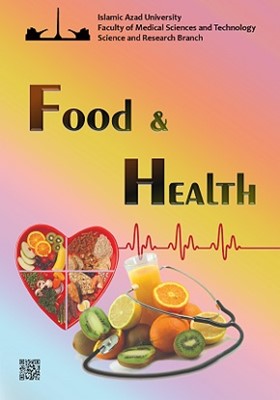Determination of antioxidant and antibacterial properties of Ferulago angulata extract obtained by maceration method and ultrasound-assisted
Subject Areas :
Seyedeh Akram Mousavi
1
,
Leila Nateghi
2
*
![]() ,
Majid Javanmard Dakheli
3
,
Yousef Ramezan
4
,
Zahra Piravi-Vanak
5
,
ladan Rashidi
6
,
Majid Javanmard Dakheli
3
,
Yousef Ramezan
4
,
Zahra Piravi-Vanak
5
,
ladan Rashidi
6
1 - Department of Food Science and Technology, Faculty of Pharmacy, Tehran Medical Sciences, Islamic Azad University, Tehran, Iran
2 - Department of Food Science and Technology, Varamin-Pishva Branch, Islamic Azad University, Varamin, Iran
3 - Department of Food Technologies Group, Department of Chemical Engineering, Iranian Research Organization for Science & Technology (IROST), Tehran, Iran
4 - Department of Food Science and Technology, Faculty of Pharmacy, Tehran Medical Sciences, Islamic Azad University, Tehran, Iran
5 - Department of Food, Halal and Agricultural Products Research Group, Food Technology and Agricultural Products Research Center, Standard Research Institute (SRI), Karaj, Iran
6 - Research Center of Food Technology and Agricultural Products, Standard Research Institute (SRI), Karaj, Iran
Keywords: / Ultrasound, Ferulago angulata, antioxidant compounds, Flavonoid compounds, / Maceration,
Abstract :
Ferulago angulata is a plant known for its phenolic compounds with antioxidant activity. This study aimed to evaluate the flavonoid content antioxidant, and antibacterial properties of F. angulata extract obtained through maceration and ultrasound-assisted extraction methods. Optimal extraction conditions for flavonoid content were determined. The maceration method yielded the highest flavonoid content (276.45 µg QE/ml) with 4 hours of extraction, 250 rpm stirring speed, and 100% ethanol solvent. The ultrasound-assisted method achieved maximum flavonoid content (375.12 µg QE/ml) with 15 minutes of extraction, 140 rpm stirring speed, and 100% ethanol solvent. The maceration extraction method showed the largest inhibition zone diameter, particularly against Staphylococcus aureus, a gram-positive bacterium, indicating strong antibacterial activity. The smallest inhibition zone diameter was observed against Escherichia coli, a gram-negative bacterium. The extraction method significantly influenced the antibacterial properties of the extracts. These findings contribute to understanding the potential applications of F. angulata as a natural source of antioxidants and antibacterial agents.

